
Cauterizing Procedure Page Menu: 1 2 3 4 5 6 7 8 Next>>
Cauterizing Procedure During the Golden Age of Piracy, Page 5
Medicinal Uses For Cautery Continued
Cautery Uses: Removing Unwanted Flesh
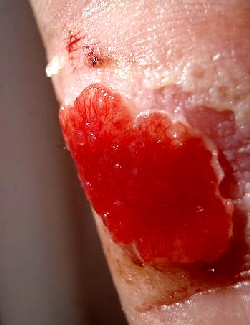
Proud Flesh (The Red Granulated Tissue
Overgrowing the Wound on a Finger)
Cauterization was sometimes used to remove the growth of unwanted flesh. Some period surgeons recommended the use of potential or chemical cauteries to remove 'proud flesh' - the swollen flesh that surrounds a healing wound or has grown larger than is wanted from inside the wound. Ambroise Paré ordered his readers to "hinder the growth of proud flesh with the cathærticks [cleansing, burning liquids], such as are burnt vitrioll [impure iron sulfate], the pouder of Mercurie, and other things, amongst which is Alome [alum] burnt and poudered [exsiccated alum], which is excellent in these kinds of wounds whether by it selfe or mixed with others."1 He suggested continuing to use these potential cauteries on the proud flesh until the wound had filled with flesh and healed.
For cancerous skin some surgeons used actual cauteries. It should be noted here that cancer at this time wasn't quite the same thing as we think of today, which is why it is included with proud flesh. Military surgeon Richard Wiseman defined cancerous skin as being "a virulent swelling, or sore, not to be cured"2. While this definition could be construed as being the same thing as some of today's cancers, the meaning appears to have been quite a bit more broad.

Author & Military Surgeon Richard Wiseman
Wiseman mentions using actual cauteries for this purpose during removal of 'a cancer of the cheek'. After cutting the cancer out and finding some of the cancer "remaining above the external Canthus [corner of the eye where the upper and lower lids meet] we consumed it by actual Cautery [irons], and dressed up the Wound with our Digestive [substance to promote healthy flesh in a wound], and Embrocations [external medicines used to moisten], Defensatives [protective medicines], and moderate Bandage to retain them."3
Wiseman commented that potential cauteries increased "cancerous Excrescences and ulcers in the Mouth" and so advised the surgeon to turn to actual cauteries or 'pallative' medicines.4 (Such medicines would relieve the pain, but not eliminate the cancer). He explains that when "the cancer be in such a place as you may hope to eradicate it, the actual Cautery is then a sure help: but not by applying it lightly upon the upper parts; but by thrusting at the root with a Scoop or Chisel-like Cautery, carrying it away before you. If there remain any rags of it, with a proportional Button-cautery burn it down to a crust; but if this cannot be effected, then endeavour Palliation by such Medicaments as above have been proposed"5.
1 Ambroise Paré, The Apologie and Treatise of Ambroise Paré, p. 155; 2 Samuel Johnson, "Cancer", A dictionary of the English language, 3rd ed.; 3 Richard Wiseman, Eight Chirurgicall Treatises, 3rd Edition, p. 112; 4,5 Wiseman, p. 105
Cautery Uses: Treating Illnesses
Cauteries

Author Jacques Guillemeau
were thought to be useful in treating various chronic illnesses by some period and near-period authors. For example, sea surgeon John Woodall advised that cautery irons "are often used with good successe" to treat epilepsy.1 French surgical author Jacques Guillemeau noted that surgeons "must alsoe sometimes cauterize the fleshe, as in the Sciatica"2.
How period surgeons felt cauterization worked to eliminate these conditions is not clear. Their conclusion that it worked at all was most likely through the process of trial and error. It is likely the some other factor or a placebo effect was actually at work.
French surgical instructor Pierre Dionis seemed to find a great deal of utility in potential or chemical cauteries to treat chronic conditions. He explained that surgeons "draw great Advantages from them to inveterate Distempers, after having in vain made use of other Remedies, as in Rheumatisms, Gouts, Defluxions [fluid discharges] of the Eyes, and in all those [medical problems] which we commonly call Catarrhous [Catarrhs - excessive discharge or buildup of mucus in the nose or throat]."3
1 John Woodall, the surgions mate, p. 10; 2 Jacques Guillemeau, The French Chirurgerie, p. 40; 3 Pierre Dionis, A course of chirurgical operations: demonstrated in the royal garden at Paris. 2nd ed., p. 468
Cautery Uses: Stopping Bleeding
"...the use of them [cauteries] is very needful, as namely, to cauterize any veine or Arterie in strong fluxes of blood which cannot otherwise be staied." (John Woodall, the surgions mate, p. 10)
Perhaps
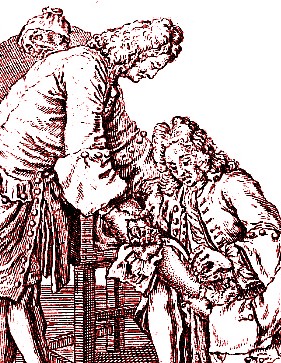
Stopping Bleeding - From "Traité des opérations de
chirurgie" by Rene Garengeot, p. 365 (1723)
the greatest support for cauterization during this era was for stopping flowing liquids, particularly as a method for arresting violent bleeding. A great many surgeons recognize this as a valid use of cauterization, dating back to Hippocrates who recommended the method to stop bleeding hemorrhoids.1
Military surgeon William Clowes advised the use of "small buttons [pieces of tow or soft lint gathered into a button-like form] or cauterizing irons meet to stay the flux of an artery or vein, if great necessity require it" when detailing his amputation procedure.2
Sea physician Hugh Ryder likewise recommended "the application of hot Cauteries, which I was forced to make use of, by reason of the largeness of the Vessels, from whence otherwise I might have expected in a few minutes his whole Mass of Blood, and Life to have been exhausted."3 German surgeon Matthias Gottfried Purmann noted during his description of the operation that if the surgical reader "may Cauterize the Veins and Arteries once or twice to stop the Bleeding; or else apply the Fuss ball [fuzz ball - similar to the buttons Clowes suggested], with my Blood-stopping Powder, and they will do the Work effectually."4
Several authors suggest the use of cauterization whenever there is hemorrhaging blood. Sea surgeon John Woodall explains this in great detail when explaining gun shot wound treatment.
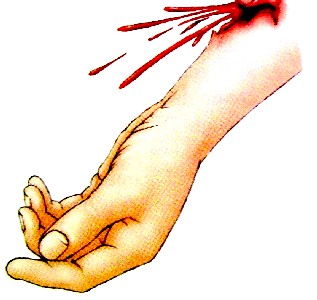
Bleeding Artery, From Pro Profs
Ch. 26 Key Terms for EMT Basic
"If you have Hamoragie, I meane bleeding or weeping of Veines or Arteries in your worke, search for that Veine or Artery that bleedeth. If you cannot make ligature [cannot tie the vessel off with a strand of silk or other thin cloth], which seldome or never you can in Gun-shott wound, then apply to the end of the Veine an actuall Cautery, a small one will serve, but apply it very hott, and not all over the wound, onely to that Veine if you can which bleedeth; you may if the Fluxe be not great, use burning hott Egiptiacoum [Unguentum Ægyptiacum - a cleansing and drying topical application] upon Lynt dipt and neately brought to the place, and then well boulstered [padded with rolls of lint - bolsters], But a small actuall Cautery is safer. Or the Surgion may use strong restrictive powder [powder to stop bleeding], adding thereunto burnt Vitrioll [impure iron sulfate - a potential cautery] a little, or burnt Allum [burnt alum - another potential cautery], and Precipitate [mercury precipitate - yet another potential cautery] missed maketh a strong Esker [eschar - coating of dead tissue]: and often restraineth great Fluxe applyed thereon.5
Military surgeon Richard Wiseman also suggested this method for arresting bleeding for gun shot wounds. He explained that in such wounds, veins and arteries "commonly lie quasht in the contused flesh, until separation of the Eschar; and about that time,
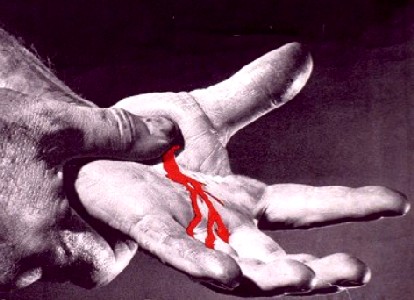
Image: Liberty Mutual Insurance - Temporarily Stopping Bleeding
when you least think on it, they may burst out violently. I have seen them thus often break forth. But if such Vessels do bleed upon the receipt of the Wound, and interrupt you in drawing out of the extraneous bodies, you must endeavour to suppress the Bleeding you bring not on a Mortification by your crowding in Dossils [wads of lint bandages]. Too many Instances may be given hereof: Therefore I rather advise you to use an actual Cautery."6
Wiseman uses cauteries to stop bleeding in other wounds as well. While removing 'cancerous' skin from the cheek of a man (mentioned above), he explains that "bloud at first spurted out forcibly from many Capillaries besides two considerable Arteries... The lesser Vessels stopped of themselves, and we cauterized the greater afterwards."7
In another case, he reports how a woman's breast was bleeding through her bandages after surgery. "Upon sight thereof I took off the Dressings, and seeing one of the Arteries seepe, I applied a fresh Dossil [piece of lint], and stopt it; but it being night, and dreading mischief might happen if it should bleed again, I sent for a small Button cautery, and that way secured it."8 Sea surgeon John Atkins discovered a similar situation for a man he was treating with a shattered ulna, causing Atkins to cauterize the hemorrhage.9
1 See Hippocrates, On Hemorrhoids, p. 151-2; 2 William Clowes, Selected Writings of William Clowes, p. 150; 3 Hugh Ryder, New Practical Observations in Surgery Containing Divers Remarkable Cases and Cures, p. 82-3; 4 Matthias Gottfried Purmann, Churgia Curiosa, p. 210; 5 John Woodall, Woodalls Viaticum, p. 6-7; 6 Richard Wiseman, Eight Chirurgicall Treatises, 3rd Edition, p. 409; 7 Wiseman, p. 112; 8 Wiseman, p. 109; 9 John Atkins, The Navy Surgeon, p. 134
Cautery Uses: Eliminating Gangrene
Cautery
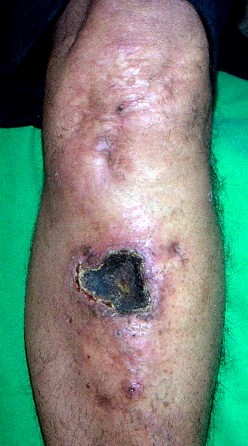
Image: CDC - Gangrenous Leg Wound
was sometimes used to stop the spread of gangrene. When treating an arm wound, Ambroise Paré stopped the bleeding and "scarified that part of the brawn of the Arme which was Gangreenated, with many and deepe incisions, shunning and not touching the inner part, by reason of the multitude of the large vessels and Nerves which runne that way; then I presently applied a cautery to some of the incisions, both to stanch the bleeding, and draw forth the virulent sanies [serum, blood and/or pus, discharged by wounds] which remained in the part."1
Richard Wiseman recommended that when an ulcer was gangrenous the surgeon should wash the wound with detergent medicines and use "Caustick and actual Cautery. ...where there is Putrefaction, you will find use for the strongest sort of Medicaments, as the actual Cautery it not only serving to remove the corrosive Flesh, but to check the malignity [stop the gangrene from spreading]; and strengthen the weak Part."2
Sea surgeon John Atkins also suggested the use of cauteries in this case, although with caution.
Actual Cautery is the last Refuge [for treating gangrene]; and is without all doubt the best Means can be used to resist Putrefaction [decomposition of the flesh]: To make it answer our Hopes, we should apply it till its Effect reaches the quick [live] Parts, and all the nasty foul Sanies bred from the cadaverous Flesh, is in a manner dry’d up; then Nature immediately commences her Efforts for separating the Quick from the Dead; which, she would contend for, with less Success, if the Cauterizing were done by halves.3
1 Ambroise Paré, The Apologie and Treatise of Ambroise Paré, p. 158; 6 Richard Wiseman, Eight Chirurgicall Treatises, 3rd Edition, p. 192; 3 John Atkins, The Navy Surgeon, p. 154

